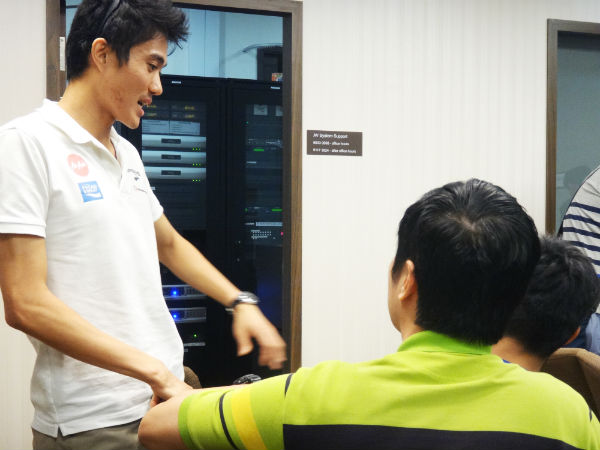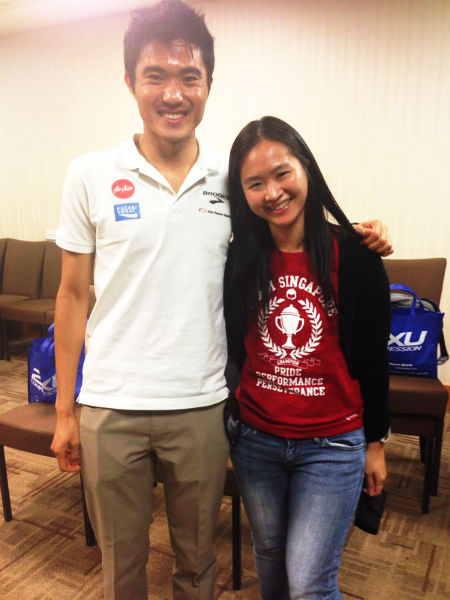To gear runners up for the Straits Times Run on 28 September, top marathoner Mok Ying Ren, gave some tips on running, last weekend.
He was the Gold Medalist in the Myanmar SEA Games marathon event last year.
Here are some of the highlights that Mok, 26, a Doctor (Captain) in the Singapore Army, shared with runners.
Work out at different speeds
In order to see running progress, Mok advised runners to do a variety of different running-related workouts and at different speeds.
To find out the optimum pace that you should complete each running workout at, you can check out running calculators, such as the ones from mcmillanrunning.com.
The main types of workouts are recovery runs, easy/long runs, tempo runs and speed workouts, according to Mok.
Recovery Run
These are the slowest running workouts and it should be done at a speed/pace that you are able to sustain for more than 42km.
These should last about 30 to 45 minutes each and are typically done at conversational pace (i.e. that is, where you are able to chitchat easily) and on the next day after a hard workout.
However, if you prefer, you can also substitute these with cross training instead, for example, by doing a relaxing swim or bike ride – according to Mok.
Easy or Long Runs
If you are doing an easy or a long run, you should complete it at a speed that you think you are able to maintain for up to 42km. So it is slightly faster than your recovery run.
These runs should each last about 90 minutes to two hours and it may help to do this type of run in a group, to prevent boredom.
Tempo Runs
These runs should be done at a pace that you are confident of being able to sustain for up to 90 minutes of continuous running. So it must be faster than your easy runs.
It can either be a continuous run that lasts 10 to 20 minutes, or an interval workout of, say, five reps of five-minute intervals, with a one-minute resting break in between.
Speed Work
This is the most taxing of running workouts and is done at a pace that you should be able to sustain for a continuous 5km to 10km run. For example, you can do reps of three to five minute intervals, with a three-minute recovery break in between each set.
Get your running technique correct
According to Mok, there are a few rules that you need to abide by, when running.
For a start, you should have a slightly forward posture when running. Try to get into a forward starting position where you feel as though you are going to fall down, but instead of actually falling, use it to kick-start your run. Maintain that forward posture throughout the run.
Also, make sure that your head is not shaking and bobbing around when you run – because by doing so, you will be wasting a lot of energy.
Your breathing should also be very controlled. You should take deep breaths and deflate fully. This is similar to the way that you breathe when you are swimming.
Recovery from Running
Eat Well
Eating well is very important if you want to run well. This means that you should eat healthy meals and try to stay away from say, deep-fried foods.
Prior to a training session, eat food that can be easily digested, such as a banana or an energy bar. The last thing you should do is to go into a training session hungry, because you won’t be able to concentrate and can’t give your all during the session.
30 to 60 minutes after a training session, it is also important to get some easily digestible food into your stomach. Chocolate milk is a good recovery beverage.
Sleep Well
Sleeping is the most under-rated form of recovery, as many runners do not get enough of it. Mok stresses that sleep is very important. A growth hormone is released when we sleep, and this allows the body to recover and grow. That is how you get stronger. If you don’t sleep well, you will never get stronger.
Use technology to aid your running
Mok recommends the usage of technology to help in running and to constantly chart your progress.
A GPS sports watch can cost between $100 to $400 depending on the model, and these can be synced to iPhone apps such as Runkeeper and Map My Run to track your improvements.
Also, listening to music and radio helps to keep the mind focused, during those easy runs and recovery sessions. But do practise caution and stay alert (for cars) if you are running on the open road, though.
Race Often
Taking part in races on a regular basis will help to constantly keep you stimulated. Mok recommends that you run races every one to two months, with about one to two high profile key races and the rest being smaller ones to gear you up for the main races.
According to the marathoner, doing so helps to keep a runner motivated because there is constantly something to look forward to just round the corner.
Run with a group
Running with a group of people helps to keep your mind stimulated and motivated too as everyone in the group can constantly egg each other on and offer positive words to encourage each other when the going gets tough.




Leave a Comment